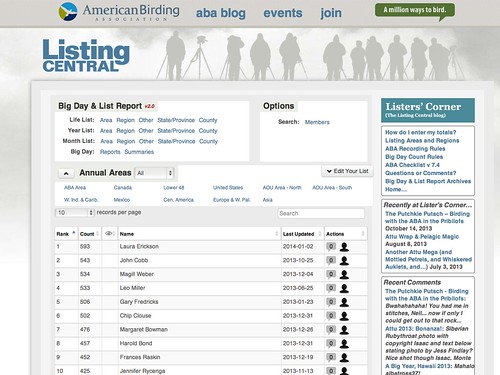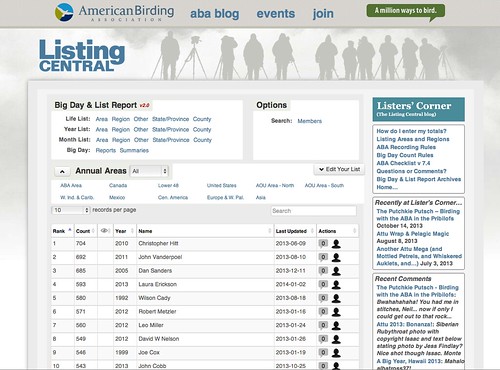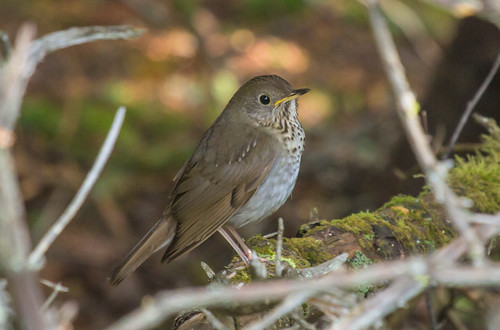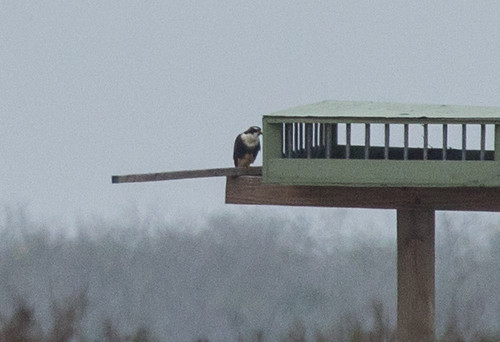These screen captures, of the top ABA Big Year Lower-48 lists, for all time and for 2013, were taken on January 2, 2014. This doesn’t include birders who post their huge continent-wide totals but don’t bother to look back and see how many were seen in the Lower-48. As other birders enter their numbers, my rankings are sure to drop, but I’ll never forget that for a moment, anyway, I was #1 in a very tiny category of a very tiny competition.
Category Archives: Uncategorized
Conservation Big Year Totals
2013 has been a whirlwind of a year for me. I set out to see and to photograph as many species as I could in the Lower 48, with a special focus on those of conservation interest. Money and time limited my options more than I’d expected due to a variety of reasons, as they are wont to do for just about anyone making big plans. For conservation reasons I also tried to consolidate travel so I could plot out driving routes to multiple good birding destinations on the same trips and to minimize the number of places I visited, which reduced my totals somewhat. I still drove a great many miles through 28 states and flew to 7 different birding destinations and made 5 trips into the ocean, including 3 pelagic trips.
I haven’t yet totaled the miles traveled by car or plane—I want to include miles in rental cars and miles driven by other people taking me to birding places, to make an accurate assessment of how much energy I squandered on my quest. I ended the year with 604 species seen in the wild. The American Birding Association has strict rules about what species can or cannot be counted. Of my list, 593 are “countable” by ABA rules (well, that total is 592 +1 right now, and if the ABA decides Rufous-necked Wood-Rail isn’t countable, I’ll be down to 592.)
Two of my “not-countable species,” the California Condor and Aplomado Falcon, had been extirpated from the US and birds now being seen are the result of reintroduction programs. These re-introduced populations aren’t yet considered self-sustaining. It’s possible that Aplomado Falcons from Mexico are still occasionally wandering north and crossing the Rio Grande. These individuals would be countable by any measure, but the trick is in knowing whether an individual originated in Mexico or from the reintroduced birds. Although they’ve not been hacking out new birds in recent years, the only Aplomado Falcons I saw this year were sitting right on the hack box, a pretty good indication that they’re part of the release program.
Two of the condors brought into captivity from the wild in the mid-1980s were re-released to the wild in the early 2000s. One, AC-8, was killed by gunshot on February 8, 2003. Another, AC-9, is still out there. I think if people see that bird’s wing tag number, they should certainly be allowed to count it as a wild, bona fide countable bird, just as we’re allowed to count banded birds or rehabbed birds after they’ve been released to the wild. All the rest of the condors in the wild were hatched in captivity, or in the wild by previously captive birds, so until their population becomes self-sustaining, the ABA won’t consider them countable. And it’s hard to predict if the population ever will be sustained without huge interventions by people. Right now, too many of the birds are dying outright after ingesting lead ammunition or by shooting. This year, California passed a law banning lead ammunition, but it won’t go into effect until July 2019. And many of the coastal condors feeding on washed-ashore sea mammal carcasses are producing thin eggs because the birds are carrying high loads of DDT. Yes, DDT was banned in the US in 1972, but a Montrose Chemical Corporation plant dumped DDT into the ocean off Palos Verde with impunity for decades until the 1970s—that dump site is now listed as an Environmental Protection Agency “Superfund” site, but sea lions never did get the memo about that, and the condors have no way of knowing these sea lion carcasses are so contaminated. That’s why the 16 pairs of breeding condors from the Big Sur area have only a 20–40 percent hatching success while those condors nesting well south of the DDT superfund site have a 70–80 percent hatching success rate.
To help ameliorate the situation, the Ventana Wildlife Society has been providing stillborn lamb carcasses when available, so the condors have a clean source of food in addition to lead-laced carcasses left by hunters and DDT-laced carcasses washed ashore, but until the population is growing without human intervention, the species won’t be considered self-sustaining, and won’t be countable by birders. A few Aplomado Falcons may wander to Texas occasionally from Mexico, but it’s usually assumed now that any birds seen in Texas were themselves released from captivity or are offspring of those birds, and the re-introduction program is recent enough that the population isn’t yet considered self-sustaining, either, though it will probably be countable much sooner than condors. Either way, these birds are essential to the conservation of their species, so I’ve counted them on my Conservation Big Year totals, but not in my ABA-countable year totals.
The other non-countable birds on my list include several feral but probably self-sustaining populations of pet birds such as some parrots. The Red-whiskered Bulbul would have been countable had I seen it in Florida, but I saw it in California, where the state committee doesn’t yet accept that it’s established. Captive individuals of some of the exotics I saw may be continually escaping into the wild, such as some parrots, Mandarin Ducks, and Graylag Geese. It’s hard to know, but because during their time mingling with wild birds they may be exposing natural populations to pathogens and certainly to at least some levels of competition, they have an impact on wild birds that I think deserves more scrutiny than if I just ignored them, especially on what I’m calling a Conservation Big Year. On the other hand, some people are likely to want to compare my numbers to those of people who have done Big Years by ABA rules, so that is why I am also including my 593 ABA total.
The trick with being a committed environmentalist and conservationist is that we see too clearly the bad impacts of the things we do, and so of course I feel guilty about all the natural resources I squandered during my quest. That also led to decisions about saving mileage by forgoing trips that would have netted me important individual species—all the trips I took that would give me one important bird were part of trips that gave me other species as well, or were part of trips with other goals. I missed some isolated birds this way, and spent more time in some areas immersing myself in the local birds than would have been sensible if I were doing a competitive Big Year. Had I been able to get away on just a few more trips I’d have easily broken 600 ABA species.
I had some bad luck and so missed some “easy” birds such as Sharp-tailed Grouse, American Golden-Plover, and Buff-breasted Sandpiper. On the other hand, I had some extraordinary luck, too. I got to see the Amazon Kingfisher that set everyone abuzz in November. The rain stopped momentarily when I was at exactly the right spot along the Colima Warbler trail to hear, and see, a Colima Warbler. And a cow at Point Reyes mooed at just the right time to draw me over–she seemed to want to be petted, and that led to my hearing and seeing the one Pacific Golden-Plover I saw this year. I was driving at 55 mph through the mountains between Carlsbad NM and Mesa AZ when I spotted the one and only Dusky Grouse I saw this year. I was mystified when I saw that one–I didn’t realize their range extended that far south, but it turned out to be the exact right spot for them in the state. Good luck and bad usually balance out, don’t they?
My year was filled with so many wonderful experiences that it would be impossible to choose my favorite—or even make a Top 10 list of the best experiences—there were simply too many. Looking back, my head is a jumble of wonderful days, wonderful places, wonderful birds, wonderful people, and wonderful moments. Unfortunately, I was overwhelmed with too many other commitments to do any kind of a good job of maintaining my blog during the year, or keeping up with processing photos, or much else—between trips, and sometimes during trips, I was too busy or frazzled to even keep up with my note-taking, thanks to home responsibilities, visits to my dear friend Ken who died in August, and commitments to complete a book about the family lives of familiar birds that’ll come out next year. I’ll be working on blog posts about the most memorable birds, moments, and places as I can now.
After I tally the number of miles, I will make a donation to some of the organizations that have been most instrumental in protecting some of my most treasured declining species, and will post about those organizations, too.
I’ll be posting a few specific recap blog posts here in coming days, and will also be going back through the year, writing new posts, but back-dating them to the right points in time, about specific birds I saw, experiences I had, and places I visited. For now, I’ll keep posting here when I write about conservation issues, especially those regarding species seen in 2013, but will return to posting other updates on my other blog.





